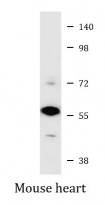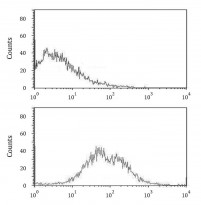ARG54803
anti-ACVRL1 antibody
anti-ACVRL1 antibody for Flow cytometry,IHC-Formalin-fixed paraffin-embedded sections,Western blot and Human,Mouse
Cell Biology and Cellular Response antibody; Metabolism antibody; Signaling Transduction antibody
Overview
| Product Description | Rabbit Polyclonal antibody recognizes ACVRL1 |
|---|---|
| Tested Reactivity | Hu, Ms |
| Tested Application | FACS, IHC-P, WB |
| Host | Rabbit |
| Clonality | Polyclonal |
| Isotype | IgG |
| Target Name | ACVRL1 |
| Antigen Species | Human |
| Immunogen | KLH-conjugated synthetic peptide corresponding to aa. 38-68 (N-terminus) of Human ACVRL1. |
| Conjugation | Un-conjugated |
| Alternate Names | ACVRLK1; ALK1; ORW2; ALK-1; HHT; EC 2.7.11.30; Serine/threonine-protein kinase receptor R3; TGF-B superfamily receptor type I; HHT2; SKR3; TSR-I; Activin receptor-like kinase 1 |
Application Instructions
| Application Suggestion |
|
||||||||
|---|---|---|---|---|---|---|---|---|---|
| Application Note | * The dilutions indicate recommended starting dilutions and the optimal dilutions or concentrations should be determined by the scientist. | ||||||||
| Positive Control | Mouse heart |
Properties
| Form | Liquid |
|---|---|
| Purification | Purification with Protein G. |
| Buffer | PBS and 0.09% (W/V) Sodium azide |
| Preservative | 0.09% (W/V) Sodium azide |
| Storage Instruction | For continuous use, store undiluted antibody at 2-8°C for up to a week. For long-term storage, aliquot and store at -20°C or below. Storage in frost free freezers is not recommended. Avoid repeated freeze/thaw cycles. Suggest spin the vial prior to opening. The antibody solution should be gently mixed before use. |
| Note | For laboratory research only, not for drug, diagnostic or other use. |
Bioinformation
| Database Links |
Swiss-port # P37023 Human Serine/threonine-protein kinase receptor R3 Swiss-port # Q61288 Mouse Serine/threonine-protein kinase receptor R3 |
|---|---|
| Gene Symbol | ACVRL1 |
| Gene Full Name | activin A receptor type II-like 1 |
| Background | This gene encodes a type I cell-surface receptor for the TGF-beta superfamily of ligands. It shares with other type I receptors a high degree of similarity in serine-threonine kinase subdomains, a glycine- and serine-rich region (called the GS domain) preceding the kinase domain, and a short C-terminal tail. The encoded protein, sometimes termed ALK1, shares similar domain structures with other closely related ALK or activin receptor-like kinase proteins that form a subfamily of receptor serine/threonine kinases. Mutations in this gene are associated with hemorrhagic telangiectasia type 2, also known as Rendu-Osler-Weber syndrome 2. [provided by RefSeq, Jul 2008] |
| Function | Type I receptor for TGF-beta family ligands BMP9/GDF2 and BMP10 and important regulator of normal blood vessel development. On ligand binding, forms a receptor complex consisting of two type II and two type I transmembrane serine/threonine kinases. Type II receptors phosphorylate and activate type I receptors which autophosphorylate, then bind and activate SMAD transcriptional regulators. May bind activin as well. [UniProt] |
| Cellular Localization | Membrane; Single-pass type I membrane protein |
| Research Area | Cell Biology and Cellular Response antibody; Metabolism antibody; Signaling Transduction antibody |
| Calculated MW | 56 kDa |
Images (3) Click the Picture to Zoom In
-
ARG54803 anti-ACVRL1 antibody IHC-P image
Immunohistochemistry: Formalin-fixed and paraffin-embedded Human cancer tissue stained with ARG54803 anti-ACVRL1 antibody.
-
ARG54803 anti-ACVRL1 antibody WB image
Western blot: Mouse heart lysate stained with ARG54803 anti-ACVRL1 antibody.
-
ARG54803 anti-ACVRL1 antibody FACS image
Flow Cytometry: HepG2 cells stained with ARG54803 anti-ACVRL1 antibody (bottom histogram) or without primary antibody control (top histogram), followed by incubation with FITC labelled secondary antibody.








